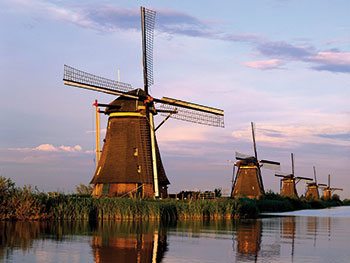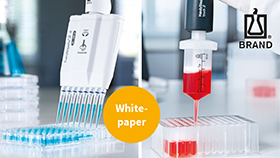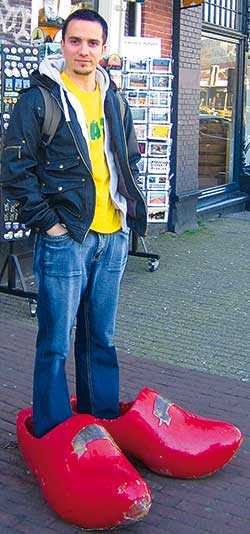Going Dutch
Career strategies for young European scientists
by Ralf Schreck, Labtimes 04/2008
Deciding to continue your career in the Netherlands means joining a country that already offers quite a variety of research programmes. Nevertheless it is aiming to expand its opportunities still further in the near future.
If you want to do research as a young European scientist in the Netherlands, “going Dutch” does not necessarily mean that you have to pay your own way. The Dutch research funding machinery has something to offer foreign scientists, too. With a population of roughly 16 million and less than 5% immigrants, the Netherlands is a medium-sized European country. Among the 27 EU countries it positioned 7th on the research and development (R&D) expenditure scale. In 2006, this amounted to E9.15 billion or 1.7% of gross domestic product. Research in the private sector largely depends on the so-called Big Seven multinational firms including Philips, Akzo Nobel, Shell and Unilever. The Netherlands is among the top five European nations when it comes to publications and patent applications. In the The Scientist 2008 survey “Best Places for Postdocs to Work”, the Netherlands Cancer Institute in Amsterdam was ranked at number 9 among non-US research institutions. Overall, when it comes to planning your next career move it is definitely worth taking a closer look at the Netherlands.
Dutch Research Landscape
If you start gathering information on research funding possibilities in the Netherlands be prepared to come across web pages, which only provide full details in Dutch. The Ministry of Education, Culture and Science (OCW) presides over the Dutch research system, in general. The OCW has an annual budget of more than E2.5 billion and is headed by the former molecular geneticist Ronald Plasterk.
In addition to the OCW, each ministry is individually responsible for research policy within its own department. For example, the Ministry for Economic Affairs is in charge of industrial and innovation-related research and development. Major players in research policy-making are the interdepartmental Committee for Economy, Knowledge and Innovation (CEKI), the Advisory Council for Science and Technology Policy (AWT) and the Royal Netherlands Academy of Arts and Sciences (KNAW).
There are 14 Dutch universities and 8 university hospitals. The research universities receive more than 50% of their annual E5.3 billion budget as a basic non-performance oriented contribution. The Royal Academy (KNAW) and the Netherlands Organisation for Scientific Research (NWO) together contribute an additional 20%. The rest has to be raised via various third-party funding sources. According to the 2007 Shanghai University Ranking, the universities of Utrecht and Leiden are among the top 20 European universities. Major players in non-university research are the 18 KNAW and 9 NWO institutes, where the focus is on specific topics, including the Netherlands Institute for Neuroscience in Amsterdam, the Hubrecht Institute for Developmental Biology and Stem Cell Research in Utrecht and the Royal Netherlands Institute for Sea Research in Texel.
Governmental research institutes such as the National Institute for Public Health and Environment (RIVM) primarily perform policy-oriented research. There are also five so-called Large Technological Institutes (GTIs) specialising, for example, in research on nuclear energy, aviation and space. They receive basic funding from the ministries but three quarters of their annual turnover of more than E250 million is earned from contract research. This also applies to a few of the more virtual Leading Technological Institutes (LTIs), where research is performed between public and private partners in the fields of nutrition, metals, polymers, telematics and pharmaceutics. The Netherlands Organization for Applied Research (TNO) is the largest institution for applied research with a staff of more than 4,700 and an annual budget of E500 million.
The Netherlands Organisation for Scientific Research (NWO)
The Netherlands Organisation for Scientific Research (NWO) is funded by the Ministry of Education, Culture and Science (OCW) and has an annual budget of more than E500 million. Funds are distributed between eight divisions, which cover all areas of science and are headed by a board of scientists. The Division of Earth and Life Sciences (ALW) and the Division of Medical Sciences (MW) are of special interest. In addition, there are temporary task forces including the Netherlands Genomic Initiative (NGI). The NWO contributes primarily towards financing universities. Furthermore, as mentioned above, it supports its nine research institutes, which primarily do research unrelated to the biomedical sector.
Almost 120 different NWO programmes and grants promote research at universities. About 6,500 full time staff are employed by the NWO: 2,500 people work specifically at NWO institutes and 4,000 people at universities. You may apply for NWO subsidies within pre-defined research programmes or participate with a project of your choice in open competition. Personal grants are available for individual researchers, including special programmes for women and ethnical minorities. Other contributions support national or international cooperation, usage of large-scale facilities and investments. And of course a couple of programmes are also open to young international talent.
Rubicon
The Rubicon programme enables Dutch postdocs to spend either up to two years abroad or one year of research at home. Non-Dutch scientists may perform research at a Dutch institution for a period of between six and 12 months. The annual budget for this programme is E5.3 million. You may apply close to the end of your doctoral research but no later than one year from obtaining your degree. Awardees of the Talent Programme, the forerunner of Rubicon, are not eligible. Research may not be performed at the institution where you received your doctorate. The 2008 deadlines are 2 September and 2 December. Applications are made via the electronic submission system, IRIS, and are evaluated without external review by multidisciplinary advisory committees. A monthly allowance is paid, as well as travel costs and research expenses of up to E230 per month. A country-specific allowance list is available at the NWO web page. Should you stay in the Netherlands, the maximum award is E55,000 per year, which is transferred direct to your employer. In 2007, 93 or 38 % of all applications were funded; this included 24 non-Dutch scientists. Usually, about three quarters of the awardees use the Rubicon money to go abroad.
“Veni”, “Vidi”, “Vici”
Established in 2000 as a joint endeavour between the NWO, the Royal Academy and the universities, currently the Innovational Research Incentives Scheme is managed by the NWO. This means big money for Dutch scientists and researchers from abroad wishing to continue their career in the Netherlands. Altogether, the allocated funds for this 10-year programme were in the range of E700 million. According to Anko Wiegel from the NWO, the programme will continue in the next years with 50% extra funding. More details will be published in autumn 2008 and new calls are expected at the beginning of 2009.
The scheme is a type of excellence programme targeting the top 10% of researchers in three age groups referred to as “Veni”, “Vidi” and “Vici”. “Veni” grants are for postdocs within the first three years of obtaining their degree and provide E208,000 in total for a period of three years. This may be used to pay for your own salary, research expenses, instruments, travel and attendance at conferences and salaries for non-research staff. Unfortunately, you have missed this round’s last deadline of 8 January 2008. In 2007, 17 % of applications from all scientific disciplines were positively evaluated and 89 “Veni” grants awarded.
“Vidi” grants are for established postdocs with the potential to develop an independent research focus and supervise one or more staff. It is for scientists who have held a PhD for three to eight years. Professors may not apply. A total of E600,000 is awarded for a five-year period. You may spend the money as described for the “Veni” grants but, in addition, you may hire PhD students, postdocs and technical staff. The 2008 deadline passed on 8 January. Eighty-three or 19% of all applicants got lucky in 2007, 64 male and 19 female scientists.
“Vici” grants are for established senior researchers who have held their PhD for eight to 15 years. Professors may also apply within three years of their appointment but no more than 15 years after obtaining their doctorate. The award of E1.25 million covers the following five years. Part of this grant may be used to invite scientists from abroad to your lab and to organise workshops and scientific meetings. The deadline for pre-proposals was on 1 April 2008; full applications have to be delivered by 2 September 2008. In 2007, 174 pre-proposals and 85 full proposals were evaluated; 30 grants were approved.
The Aspasia programme for female scientists, which was established in 2000 to promote women from lecturer to senior lecturer or assistant professor to associate professor, has recently been modified. It is now linked to the “Vidi” or “Vici” subsidies and universities actively promoting female “Vidi” or “Vici” laureates receive additional funding from the NWO.
Open Competition
Several NWO divisions offer the possibility to apply with a freely chosen “high-risk” research project. In the Division of Earth and Life Sciences (ALW) this openly competitive programme has an annual budget of E7 million. Irrespective of age and nationality, applicants have to undertake research in two broad areas: (1) ‘Geo and Bio Sphere’, or (2) ‘From Molecule to Cell’. On average, decisions on funding are reached after eight months and, in the past, 30 % of all applications have been granted. You may apply for a four-year research project and request staff, equipment, consumables and travel. However, requests for your own salary will be denied.
Dutch Genomics
The Netherlands Genomic Initiative (NGI) was established in 2002. It enters its 2nd five-year funding period this year with an expected volume of E280 million to be provided by the government. Young talent performing research on genomics or bio-molecular informatics is promoted by the Horizon Programme worth E20 million in total. There are two Horizon funding lines: Breakthrough and Zenith projects. A Breakthrough project is a short-term project (from 12 to 18 months). In the 2nd period about 100 scientists will be selected in three application rounds and receive up to E100,000 to implement a novel project. Applications are accepted from Dutch as well as foreign researchers holding a temporary or permanent position at a Dutch research institution. You may apply within ten years of obtaining your doctorate. Scientists with permanent employment may ask for scientific or non-scientific staff, whereas temporarily employed scientists (including postdocs) may ask for their own salary. Employment of PhD students is not allowed in Breakthrough projects due to their explorative, short-term and high-risk nature. The 1st call for Breakthrough projects in their 2nd round closed on 19 February 2008. The success rate for Breakthrough projects in the 1st five-year period was about 11%.
In the second phase, about 20 scientists who have already demonstrated their talent will be given the possibility to expand their work in the context of a Zenith project worth E500,000. A recent Breakthrough project is not a requirement but certainly a plus during the evaluation process. There are also three calls planned. At the beginning of June there was still no active call for Zenith projects. The success rate of a Zenith application in the first funding period was about 7%.
The Royal Netherlands Academy of Arts and Sciences (KNAW)
This year, the Royal Netherlands Academy of Arts and Sciences (KNAW) celebrates its 2nd centenary. The main role of KNAW is to foster excellent research in the Netherlands, advise the government on scientific matters and provide a forum for national and international cooperation. The Academy has two divisions: the Science Division and the Humanities and Social Sciences Division. Each division has its own board. At the core of the Royal Academy are about 200 regularly elected scientists under the age of 65. In addition, there are resting members (regulars above 65), foreign members and correspondents. In order to bring in fresh blood and talent, the KNAW has practised electing younger scientists into the Young Academy since 2005. Members of the Young Academy will have received their PhD within the last ten years and may remain part of the Young Academy for five years. However, if it comes to decisions on research funding and policies they do not have the same rights as the regular members.
The KNAW budget in 2006 was about E133 million. Most of its funds go directly to the 17 KNAW research institutes and its 1,300 staff. There are several grants, prizes and smaller research programmes provided by the KNAW but they are not really worth a mention here in the context of promoting independent young talent. There is an Academy Professorship Programme, which pays E1 million for a five year period and four of these professorships are awarded each year, but the target group is professors in their late 50’s. Unfortunately, there is no KNAW annual report available in English and the English news section of the web site is scanty.
The Hubrecht Institute for Developmental Biology and Stem Cell Research at Utrecht is one of the KNAW’s primary research institutes with a staff of about 150 people. The scientific work on colon stem cells by its managing director, Hans Clevers, was recently featured in Lab Times (Vol. 2/2008, p.28). The institute also harbours two awardees of an ERC starting grant: Rene Ketting and Marcel Tijsterman. In February, the Hubrecht Institute announced their collaboration with the University Medical Center Utrecht (UMC Utrecht), which will lead to an increase of its core financing from E5.7 to E9.7 million. It is definitely the place to be if you are interested in developmental and stem cell biology.
The Netherlands Cancer Institute
The internationally renowned Netherlands Cancer Institute (NKI) in Amsterdam with research staff and support personnel of about 550 people performs basic, translational and clinical cancer research. According to the managing scientific director, Anton Berns, the NKI offers excellent opportunities for young scientists, “We are an independent institution but with a substantial training programme for PhDs (we have over 100 PhD students) and close to 30 of our staff hold professorships at universities. We also have young group leader positions that are evaluated after five years. At that time it is decided whether they will receive tenure. They receive start-up funding and, with external funding, can build a group. Invariably the young group leaders are capable of establishing groups of 5-10 people in a short period. We are an internationally operating institute and it is easy for foreigners to integrate. We also have many foreign postdocs and students. Language in the institute is English. Amsterdam is a metropolitan in which foreigners feel rather comfortable, socially.”
In order to improve the Dutch funding situation Anton Berns also demands more competitive grants with overheads, more public funding and the reduction of bureaucracy, “In spite of criticism the overall quality of research is very high. There are lots of opportunities for talented scientists, especially since many vacancies are expected due to retirements in the next 5-10 years.” In summary, if one takes into account the high reputation of the NKI and the fact that the Dutch Cancer Society is spending more than E50 million on research each year, the prospects for a career in cancer research seem to be quite bright in the Netherlands.
Outlook
Recently, strategic plans were published by the NWO called “Science Valued!” and by the Royal Academy called “Sustainable Science”, covering the years 2007 to 2010. Both organisations requested a substantial rise in their annual budgets. The NWO wants an additional E433 million primarily to improve infrastructure and support a couple of new initiatives, particularly in the areas of Brain and Cognition, Nanoscience and Nanotechnologies or Systems Biology. Career improvements for young scientists will be realised by increasing the budget for existing talent programmes. Another line of action is a special fund to recruit top international researchers to the Netherlands. The Royal Academy wants to further strengthen their leading institutes by pouring in more money but expects them to be more flexible and responsive to novel developments in the respective research fields. The Academy also intends to attract more young talent by providing personalised grants and intensifying collaboration with Dutch universities.
Both organisations also want to expand the European dimension of Dutch research. In recent years Dutch researchers have been particularly successful in attracting grants and awards at the European level. One example is the Starting Grant of the European Research Council (ERC). This grant amounts to a maximum of E2 million for five years. Among the top 200 short-listed awardees of the 1st selection round, 18 researchers are currently working at Dutch institutions. In addition, 26 scientists on the reserve list want to practise research in the Netherlands. Another example is the EMBO Young Investigator Programme. As previously mentioned it’s not only the cash but also the reputation and networking activity that makes this award attractive. Since the programme commenced, about 18% of all YIP awardees have decided to do research in the Netherlands. Overall, the Netherlands seems dedicated to performing top international research by investing a significant part of its limited resources. In addition, it is offering a wide spectrum of career opportunities for national and international talents. Try your luck!
Internet Resources
Last Changed: 09.06.2012









